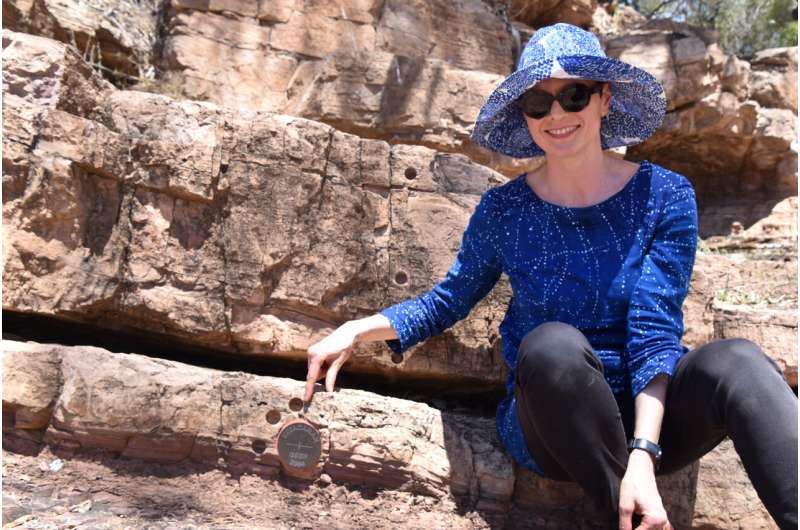This article has been reviewed according to Science X's editorial process and policies. Editors have highlighted the following attributes while ensuring the content's credibility:
fact-checked
peer-reviewed publication
trusted source
proofread
Mars attracts: How Earth's interactions with the red planet drive deep-sea circulation

Scientists from the Universities of Sydney and Sorbonne University have used the geological record of the deep sea to discover a connection between the orbits of Earth and Mars, past global warming patterns and the speeding up of deep ocean circulation.
They discovered a surprising 2.4-million-year cycle where deep currents wax and wane, which in turn is linked to periods of increased solar energy and a warmer climate.
The study, published in Nature Communications, tackles the questions of how geological-timescale climate change affects ocean circulation and how this could help scientists model future climate outcomes. The researchers sought to find whether ocean-bottom currents become more vigorous or more sluggish in a warmer climate.
These cycles are not linked to the current rapid global warming caused by human greenhouse gas emissions. However, the study has identified deep eddies associated with warming seas that could counter ocean stagnation predicted to impact the AMOC (Atlantic Meridional Overturning Circulation) that drives the Gulf Stream and maintains temperate climates in Europe.
Lead author ARC Future Fellow Dr. Adriana Dutkiewicz from the University of Sydney EarthByte Group in the School of Geosciences and co-authors used more than half a century of scientific drilling data from hundreds of sites worldwide to understand the vigor of deep-sea currents through time.
Dr. Dutkiewicz said, "A break in sedimentation indicates vigorous deep-sea currents, while continuous sediment accumulation indicates calmer conditions. Combining these data with advanced spectral data analysis has allowed us to identify the frequency of breaks in sedimentation over 65 million years."
In a collaboration with Professor Dietmar Müller (University of Sydney) and Associate Professor Slah Boulila (Sorbonne), Dr. Dutkiewicz used the deep-sea sediment records to check for links between sedimentary shifts and changes in Earth's orbit.
They found that the vigor of deep-sea currents shifts in 2.4-million-year cycles.
These cycles are called "astronomical grand cycles," predicted to occur due to the interactions of Earth and Mars orbits. However, evidence for this is rarely detected in the geological record.
Dr. Dutkiewicz said, "We were surprised to find these 2.4-million-year cycles in our deep-sea sedimentary data. There is only one way to explain them: they are linked to cycles in the interactions of Mars and Earth orbiting the sun."
Co-author Professor Müller added, "The gravity fields of the planets in the solar system interfere with each other, and this interaction, called a resonance, changes planetary eccentricity, a measure of how close to circular their orbits are."
For Earth, it means periods of higher incoming solar radiation and warmer climate in cycles of 2.4 million years. The researchers found that the warmer cycles correlate with an increased occurrence of breaks in the deep-sea record, related to more vigorous deep ocean circulation.
This result is unexpected, as indications from observations and ocean models suggest that the current Atlantic circulation system, the AMOC that produces the Gulf Stream, may shut down in a warmer climate due to sea-ice melting.
However, Professor Müller said, "The freezing and melting of sea ice is not the only mechanism influencing deep ocean circulation. Deep-ocean eddies are predicted to intensify in a warming, more energetic climate system as major storms become more frequent."
These eddies are like giant whirlpools and often reach the abyssal seafloor, resulting in seafloor erosion and large sediment accumulations called contourites, akin to snowdrifts.
Dr. Dutkiewicz said, "Our deep-sea data spanning 65 million years suggest that warmer oceans have more vigorous deep circulation. This will potentially keep the ocean from becoming stagnant even if Atlantic Meridional Overturning Circulation slows or stops altogether."
How the interplay between different processes driving deep-ocean dynamics and ocean life may play out in the future is still not well known, but the authors hope that their new results will help with building better climate models.
More information: Dutkiewicz, A. et al. Deep-sea hiatus record reveals orbital pacing by 2.4 Myr eccentricity grand cycles, Nature Communications (2024). DOI: 10.1038/s41467-024-46171-5
Journal information: Nature Communications
Provided by University of Sydney





















